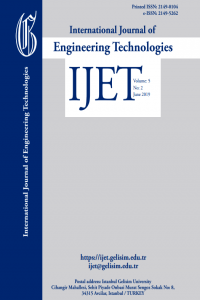Performance Assessment of Advanced Biological Wastewater Treatment Plants Using Artificial Neural Networks
In this study, the application of Artificial Neural Network (ANN) techniques was used to predict the performance of wastewater treatment plant. The ANN-based model for prediction of effluent biological oxygen demand (BOD) concentrations was formed using a three-layered feed forward ANN, which used a back propagation learning algorithm. Based on the mean absolute percentage error (MAPE), the sum of the squares error (SSE), the absolute fraction of variance (R2), the root-mean-square (RMS), the coefficient of variation in percent (cov) values, and ANN models predicted effluent BOD concentration. The R2 values were found to be 94.13% and 93.18% for the training and test sets of treatment plant process, respectively. It was found that the ANN model could be employed successfully in estimating the daily BOD in the effluent of wastewater biological treatment plants.
Keywords:
Artificial neural network, Biological oxygen demand, Modeling Performance assessment, Wastewater treatment plant,
___
- Cinar O, Yilmaz A., “Application of Artificial Neural Network Method on Operation of Wastewater Treatment Plant: An Example Study”, KSU. Journal of Science and Engineering, 8(2): 48-52, 2011.
- Lee D S, Park JM., “Neural network modeling for on-line estimation of nutrient dynamics in a sequentially-operated batch reactor”, Journal of Biotechnology, 75: 229–239, 1999.
- Cote M, Grandijean B P, Lessard P, Yhibault J., “Dynamic modeling of the activated sludge process: improving prediction using neural networks”, Water Research, 29: 995–1004, 1995.
- Hamed M, Khalafallah M G, Hassanein E A., “Prediction of wastewater treatment plant performance using artificial neural network”, Environmental Modeling and Software, 19: 919–928, 2004.
- Wen C. H., Vassiliadis C. A., “Performing hybrid artificial intelligence techniques in wastewater treatment”, Engineering Applications of Artificial Intelligence, 11: 685-705, 1998.
- Choi D., Park H., “A hybrid Artificial Neural Network As A Software Sensor for Optimal Control of A Wastewater Treatment Process”, Water Res., 35: 3959-3967, 2001.
- Mjalli F. S., Al-Asheh S., Alfadala H. E., “Use of artificial neural network black-box modeling for the prediction of wastewater treatment plants performance”, J. Environ. Manage., 83: 329-338, 2007.
- Mingzhi H., Ma Y., Jinquan W., Yan W., “Simulation of a paper mill wastewater treatment using a fuzzy neural network”, Expert Systems with Applications, 36: 5064-5070, 2009.
- Zhang Q., Stanley SJ., “Real-timewater treatment process control with artificial neural network”, J Environ Eng. ASCE, 125: 153–160, 1999.
- Yu RF., Cheng WP., Chu ML., “On-line monitoring ofwastewater true color using digital image analysis and ANN”, J Environ Eng. ASCE, 131: 71–79, 2005.
- Oztemel E., “Artificial Neural Networks”, Papatya Publication, İstanbul, 2003.
- Cınar O., “New tool for evaluation of performance of wastewater treatment plant: Artificial neural network”, Process. Biochem., 40: 2980–2984, 2005.
- Delgrange V. N., Cabassud N., Cabassud M., Durand-Bourlier L., Laine J. M., “Neural networks for prediction of ultrafiltration transmembrane pressure: application to drinking water production”, Journal of Membrane Science, 150: 111–123, 1998.
- Demuth H., Beale M., Hagan M., “Neural Network Toolbox 5: Users Guide”, Natick. MA The MathWorks Inc., 2007.
- Kalogirou S. A., “Applications of artificial neural-networks for energy systems”, Applied Energy, 167: 17–35, 2000.
- Lu W., “Neural network model for distortional buckling behaviour of coldformed steel compression members”, Ph.D. thesis, Helsinki University of Technology, 2000.
- Machon I., López H., Rodríguez-Iglesias J., Maranˇón E., Vázquez I., “Simulation of a coke wastewater nitrification process using a feed-forward neuronal net”, Environmental Modelling and Software, 22: 1382–1387, 2007.
- Pala M., “A new formulation for distortional buckling stress in cold-formed steel members”, Journal of Constructional Steel Research, 62: 716–722, 2006.
- Berke L., Patnaik S. N., Murthy P. L. N., “Optimum design of aerospace structural components using neural networks”, Computers & Structures, 48(6): 1001–1010, 1993.
- Kang H. T., Yoon C. J., “Neural network approaches to aid simple truss design problems”, Microcomputers in Civil Engineering, 9: 211–218, 1994.
- N., Pala M., Elmas M., Eryılmaz D. M., “A new approach to determine the base shear of steel frame structures”, Journal of Constructional Steel Research, 65: 188-195, 2009.
- ISSN: 2149-0104
- Başlangıç: 2015
- Yayıncı: İstanbul Gelişim Üniversitesi
